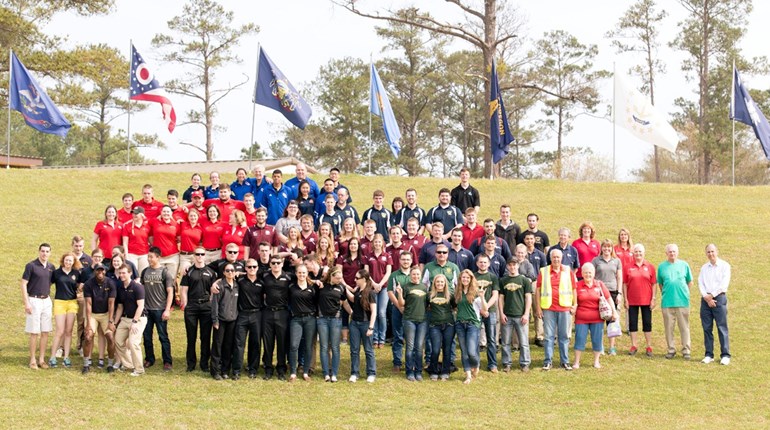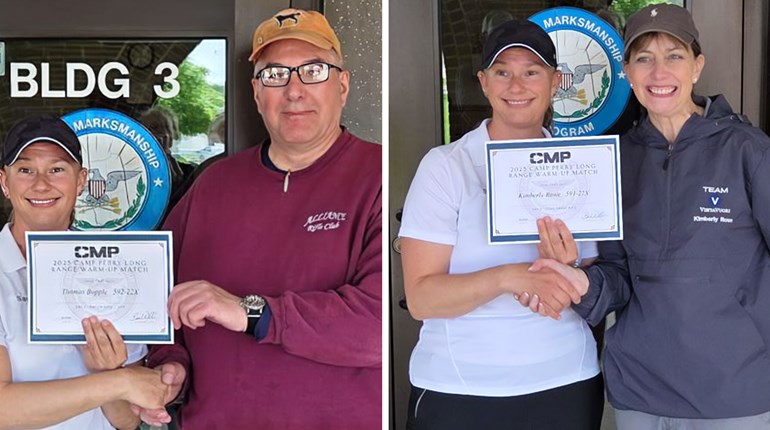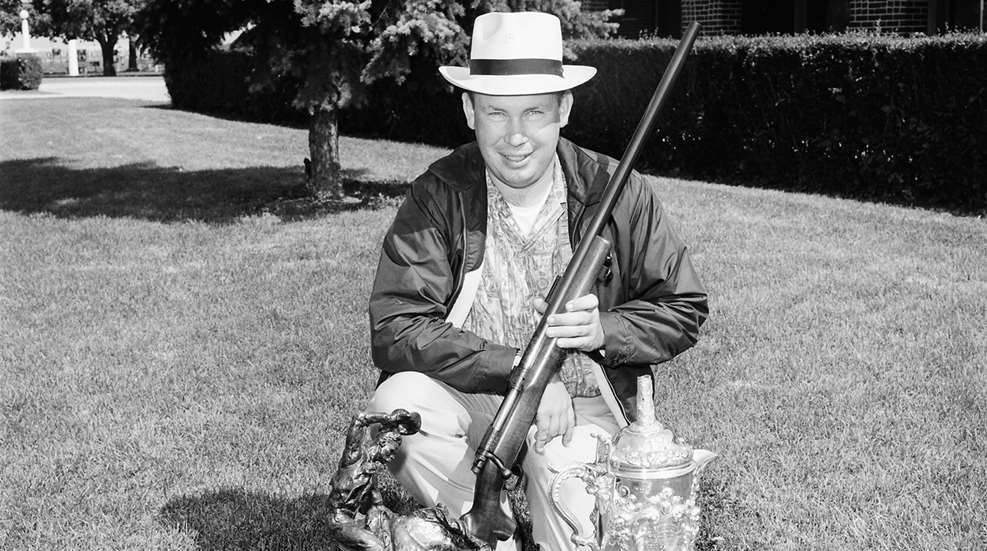
Editor’s note: This is the second installment of a three-part series, which was initially published in the February 2000 issue of Shooting Sports USA. Read Part 1 here.
Here we present the second of our three-part series on the top 50 shooters of the 20th century. Selecting only 50 shooters was difficult indeed as our panel of shooting sports experts reflected on the accomplishments made by these marksmen and the indelible impressions they’ve made on the community of firearms competitors.
While many people over the years have had more than just a single moment in the spotlight, what we were really looking for was longevity in a shooting career, not just a back to back win here and there, but repeated victories over a decade or more of competition. We also looked at the significant contributions many have made to our sport.
Remember that many of these shooters were not only great “for their time,” but in fact accomplished so much with so little of the technology today’s shooters experience. In that light, these shooters represent a short history lesson of both the NRA and the sport of shooting. The list is in alphabetical order and does not reflect any particular ranking.
Gertrude Backstrom
Call her the predecessor to Ruby Fox. Call her a great little housewife always dressed like a lady. Call her what you will, but Gertrude Backstrom did for women’s pistol shooting what almost nobody else has done: She beat the men.
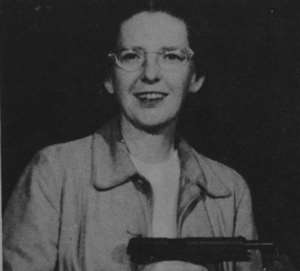
Backstrom’s career was not of the 20 year or more duration exhibited by many of our top 50 picks. She appears from archival photos to be a typical 1950s-era housewife, pictured in a gingham dress with a sweater for a shawl. But those photos of Backstrom, taken with a winning target and posed with her .45, proves she was a force to be reckoned with. She won an unprecedented four consecutive Women’s National Pistol Championships, from 1955 through 1958. She even won the centerfire rapid fire phase of the 1958 Matches, but that wasn’t her greatest coup. Her finest moment occurred at the National Matches of 1957. That year’s contest not only handed her a third women’s title, she also laid claim to the overall civilian title, the first and only woman to obtain that honor in NRA’s competitive pistol shooting history.
Alice H. Bull
Honored by many in the shooting community as the “first lady” of competition, Alice H. Bull tallied a staggering list of accomplishments and set an admirable standard for her fellow shooters. She began her shooting career in 1929 as a member of the University of Washington women’s rifle team. She went on to gather a plethora of state, regional and national shooting titles. Among her many honors, Bull made the President’s 100 in 1936, the first woman to ever do so.
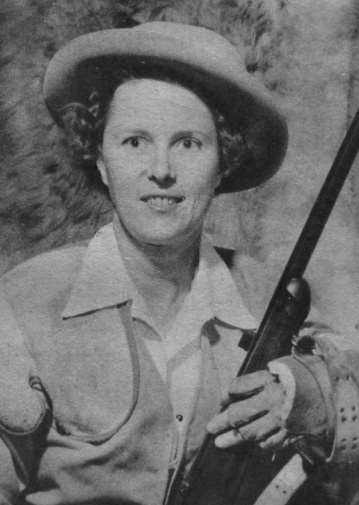
Bull’s talents on the firing line at Camp Perry were legendary as evidenced by four National Women’s High Power Rifle Championships. Still going strong in 1961, she also earned the coveted Department of Defense Distinguished Rifleman’s badge.
Over the years, Bull gave endlessly of her personal time and experience to promote shooting. She organized the Greater Seattle Shooters Council, teaching marksmanship to civilians headed for duty in the Korean War. She was also the first woman promoted to the National Board for the Promotion of Rifle Practice. Bull later pioneered legislation requiring hunter education for all hunters, fought against anti-gun initiatives, and battled for sound wildlife management practices.
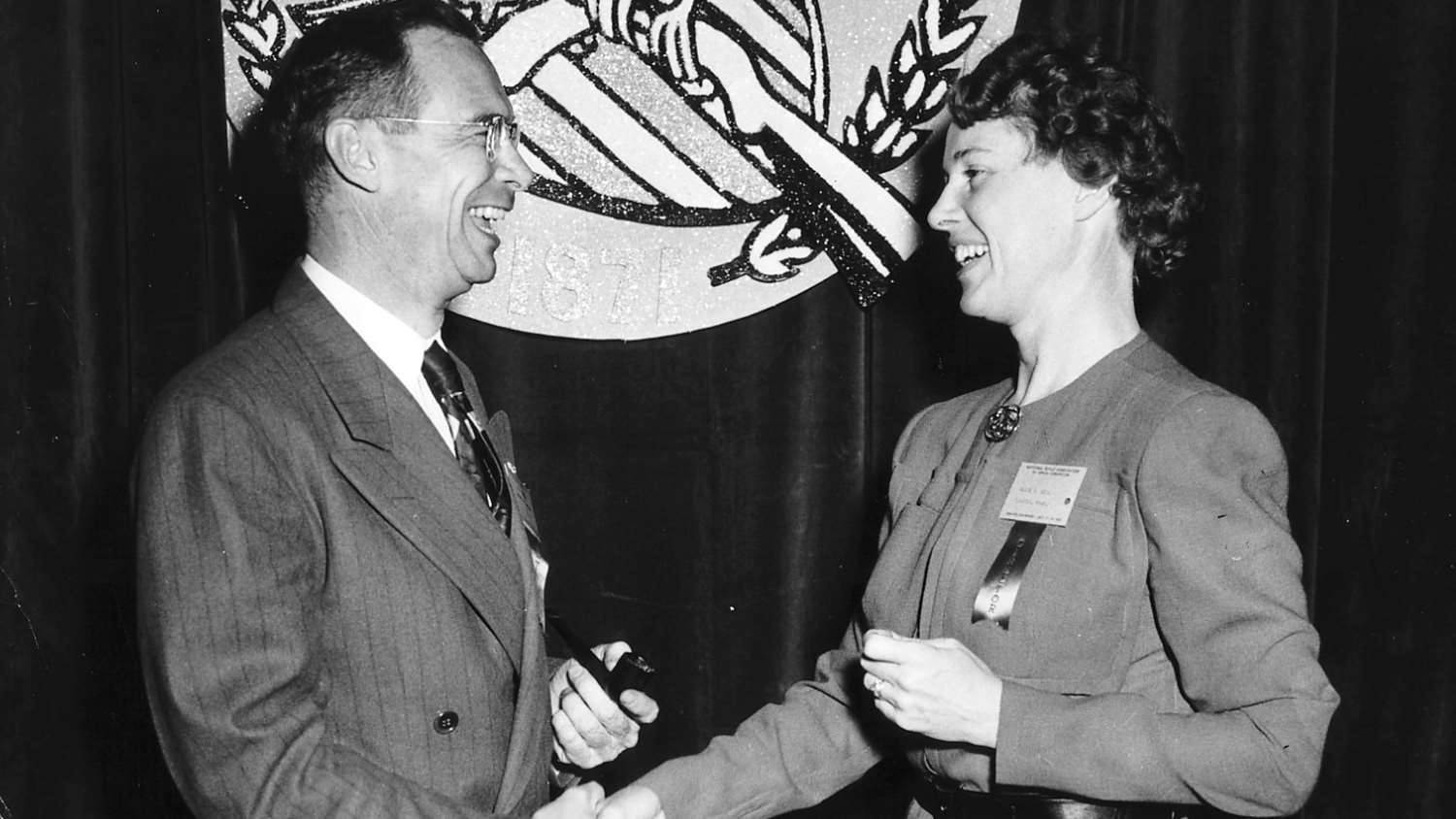
In 1949, Bull added another to her list of “firsts” by becoming the first woman elected to the NRA Board of Directors, serving in that capacity until 1988. She was unanimously awarded an NRA Honorary Life membership in 1981, an honor bestowed on only 15 others in the NRA’s 129-year history. The Alice H. Bull Endowment for Collegiate Shooting Programs, established through the NRA Foundation after her death in 1988, continues her legacy.
Captain E. C. Crossman
As hailed in his obituary in the March 1939 issue of the American Rifleman, “Ned Crossman was one of the very few men of this or any other generation of American riflemen whose experience embraced the problems of the sportsman in the field, the civilian on the rifle range, the citizen soldier, the officer in the Army Ordinance Department, and the scientific crime detection laboratory.” Such laurels were due a man who contributed so much to the shooting sports during his lifetime.
A long standing director of the NRA, Crossman’s technical knowledge had a solid basis in his own marksmanship skills. He was among the elite civilian riflemen chosen from the ranks of the NRA to staff as rifle instructors, the first Small Arms Firing School at Camp Perry in 1918. His interests turned to the technical side of firearms mechanics and ammunition after the end of World War I. Based on his reputation, he was assigned with other ordinance officers to conduct field tests on the .30-′06 Springfield Cartridge. Crossman’s significant contribution to the development of the effective range of the M1 .30 cal. cartridge let the American solider take the guess-work out of their riflery (many of the .30-′06 “statistics” were based on theory previous to Crossman’s work) by giving them true figured on which their firing tables could be based.
As a result of his experiences with the .30-′06 development, Crossman was given assignment to the revived 1919 National Matches at Caldwell, NJ. There he became instrumental in developing Caldwell’s smallbore range as he pressed forth his beliefs that the .22 rifle was the training weapon of the future and the perfect way to introduce civilians to shooting games. His efforts earned him regard as the “real father of smallbore shooting in America.”
Crossman went on to contribute to the shooting community with his prolific writings. He is generally considered to be the first “gun editor” of this country, writing technical articles on everything from firearm mechanics, to skeet and forensic ballistics. Speaking after his death, Townsend Whelen commented that Crossman “… has done a truly remarkable work in the interest of the promotion of rifle practice.”
Major General Merritt A. Edson
Merritt Edson began life in a small town in Vermont in 1897. That town turned out to be the only small thing about Edson’s life.
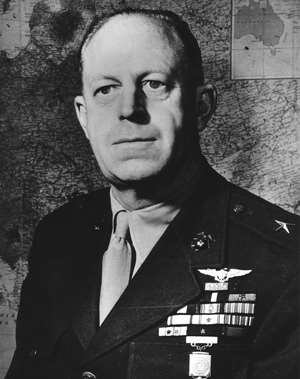
Enrolled at the University of Vermont in 1916, Edson enlisted with the U.S. Marine Corps at the outbreak of World War I and never looked back. In 1921 he discovered competition and shot with the winning Marine Corps Rifle Team. He was then attached to the Corp’s rifle and pistol teams as the assistant coach in 1928, 1930 and 1921, moved on to head coach in 1932, and then to team captain in 1933, 1935 and 1936.
Edson made large strides in both his military service and in competitive shooting leadership. A willingness to go to war for his country turned into a lifelong career of military highlighters: he made Squadron Commander in 1925; earned a Navy Cross for valor during combat in Nicaragua in 1927; became Commanding Officer in 1941 of the First Battalion, 5th Marine Regiment, a command that led to organizing the 1st Marine Raider Battalion (the prototype for the Raider and Army Ranger units of today); awarded a Gold Star in 1942 for the siege of Tulagi in the Solomon Islands; awarded our nation’s highest honor, the Congressional Medal of Honor in 1942.
Edson retired in 1947 and became the Commissioner of Public Safety of Vermont and thereby the first head of the newly established Vermont State Police force. He had returned to his competitive shooting roots the year before to serve as the U.S. delegate to the International Shooting Union. A life member of the NRA since 1933, he’d been elected a Director of the Association in 1939. In 1948 he became the NRA’s Vice President and the President in 1949. Edson became the NRA’s Executive Director in 1951. The following year he became Vice-President for the ISU’s North America division. His contributions to various programs during his tenures with both organizations are too numerous to list. Edson held both of his last NRA and ISU positions until his death in 1955, culminating a career devoted to rifle training, marksmanship and American freedom.
George R. Farr
Compared to the others listed in our top 50 shooters of the century, George Farr had a relatively short-lived career on the firing line. While his name does not appear with frequency in the record books, he did possess a fine reputation for his long range abilities among his peers on the 1910s and 1920s. In fact, Farr’s skills at taking running game over great distances were legendary among shooters of his native Pacific Northwest. But “Dad Farr” as he was known among his hundreds of friends and shooting companions, did have his “15 minutes of fame.”
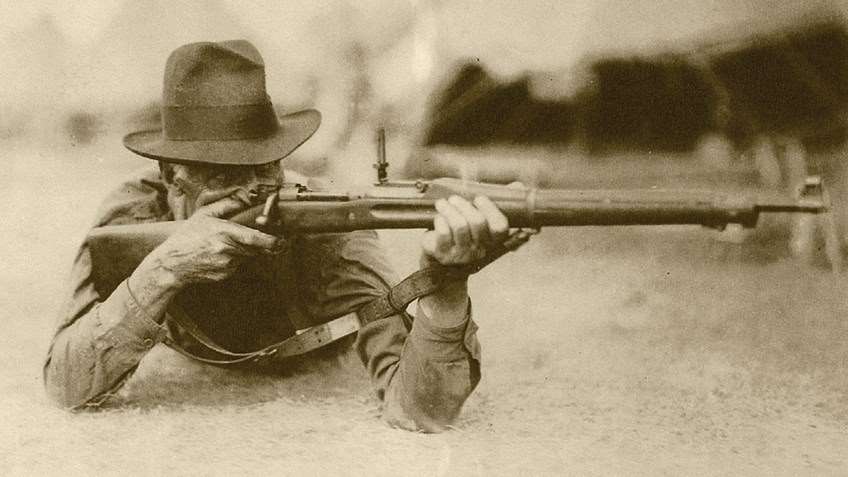
In 1921, Farr was shooting with the Washington State Civilian Team at the National Matches when he made his mark in the Wimbledon Match. Farr shot 71 consecutive bullseyes and according to spectators, only the fading light of the sunset prevented him from continuing to score. The 71 bullseyes were remarkable, not just because they were a fabulous long-run, but because the man who shot them was 62 years-old and he set his world-record firing Service Rifle with iron sights.
As a result of Farr’s phenomenal shooting, the 2,000 riflemen gathered at Camp Perry that year claimed him as their hero and by voluntary contributions, donated a massive silver bowl to be known as the George R. Farr Trophy. In honor of Farr’s amazing shooting, the trophy has been given since 1922 to the high scoring competitor firing Service Rifle over the 1000-yard Wimbledon course.
Harry M. Pope
Harry Pope held a position of esteem head-and-shoulders above almost every rifleman of his era, and he did so for more than 50 years. His skills as a barrel maker were only surpassed by those of his marksmanship. He was already one of the country’s best marksman in 1895 when he completed courses at MIT. Shortly after, one of his most famous designs came to light, Pope’s eight-groove, gain-twist barrel. These barrels were fitted on the Improved Krag-Jorgenson Government rifles used by the 1903 Palma Team and were given much credit in the American’s victory that year. However, those same barrels also became the scandal that caused the return of the Palma to the British. Pope’s barrels were a replacement for the rifles’ original equipment. Unsubmitted government paperwork on the part of the American team caused those rifles to be “unapproved for authorized use,” the crucial approval being a stipulation of the Palma conditions.
Pope spent his lifetime as an avid target shooter, hunter and craftsman. His superlative shooting skills were overshadowed by the high quality of his barrels, the best in the world in their day. Pop produced the barrels on a worn lathe and with a boring machine he had made himself. His death in 1950 marked the end of an era when it was possible for a highly skilled, individual man to successfully compete with modern, precision machinery.
Brigadier General Bird W. Spencer
The Board of Director of the still-young National Rifle Association, rose from a nearly decade long dormancy in December of 1900, and elected Brig. Gen. Bird W. Spencer its new president. Spencer was a natural selection for the top slot of the newly revised organization, having been president of the New Jersey State Rifle Association (NJSRA).
It was Spencer’s authority within the NJSRA that had prompted the financially distressed NRA to transfer the conduction of its annual match from Creedmoor to the new Sea Girt range owned by the state association. Spencer and the NJSRA took over all aspects of running the National Matches, upkeep of the records, and care of the various trophies. Spencer was especially qualified to run the New Jersey association as his long military career had included a stint as the New Jersey Inspector General of Rifle Practice.
One of the NRA’s founders, Spencer’s love for competition, both as a competitor and an organizers, was the force behind the growth of match popularity at Sea Girt. An excellent marksman himself, Spencer participated in the skirmish matches of the day. He went on to captain the 1901 Palma Team in the first Palma match after a nearly 20-year hiatus. His personal dedication to and roots in marksmanship and competition promoted the success of not only Sea Girt ad the NRA, but work in Congress that helped to eventually produce the National Board for the Promotion of Rifle Practice. His last contribution to the shooting community was to offer National Matches during a struggling national economy. To that end he served as commandant of the matches. He died in the clubhouse of the rifle range he loved so much in 1930.
Gerritt Stekeur
Gerritt Stekeur in one of those shooters that comes into glory every so often, fades from the picture, and then comes back again as if he’s never left. His first win on the NRA’s record books was in 1959 and it was a big one: the Palma Individual fired under new match conditions when the trophy was reinstituted following its 27-year absence from competition. That year’s trophy was awarded to the civilian scoring the high aggregate of the Navy Cup, Coast Guard, Marine Corps Cup, Members’ Trophy, and Crowell Trophy Matches. After winning the Palma Individual, he went on as an Army National Guard Staff Sergeant to claim the 1960 National Guard Association Trophy.
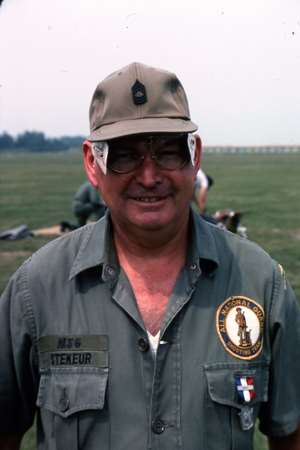
Stekeur would be missing from the national awards list for more than a decade when he staged a comeback. In 1971 he won the Townsend Whelen award in its first year of designation for the high senior firing service rife in the high power National Matches. He missed the win in 1972, but came back in 1973 for the title. From there he earned the senior title in repeat wins, every year for 12 years, until 1985. In 1975 he also regained the National Guard Association Trophy, 15 years after he’d won it the first time. In 1978 he took the high civilian service rifle title in the National High Power Championships, a title he repeated for the next two years. Still going strong, he claimed the Whelen trophy again in 1990, and the more recent Louis F. Lucas Trophy in both 1990 and 1991.
Mary Stidworthy
Mary Stidworthy began winning in 1973 as the Prone Any Sight Women’s Champion. She won that title eight more times over the next 10 years. So strong were her shooting skills that she also retained the title of Women’s National Smallbore Rifle Champion for an unprecedented seven year run beginning in 1977. Throughout her tenure as national champion, many other awards came her way.
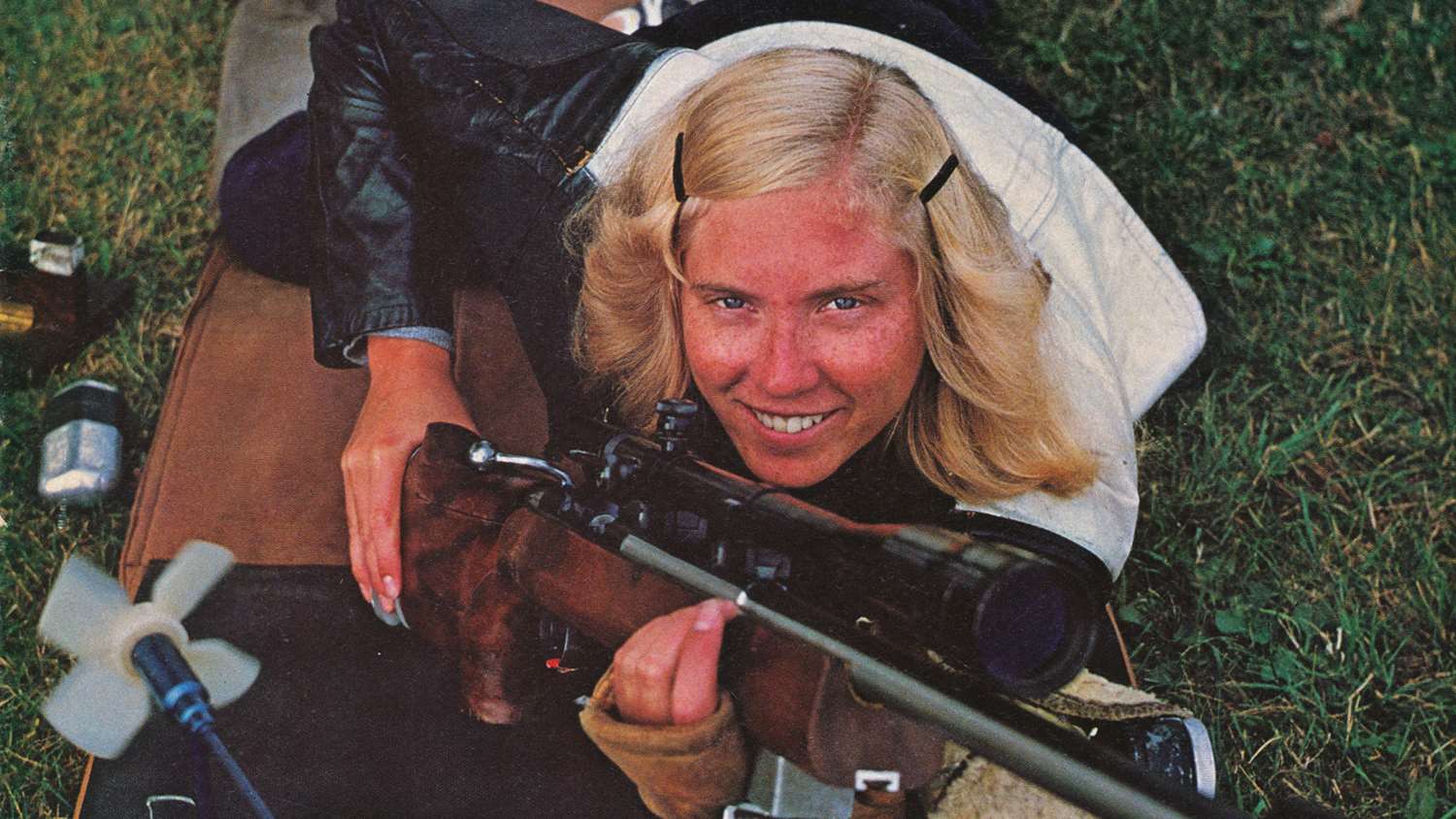
As a Specialist-5 with the Arizona Air National Guard in 1980, she took the Austin Trophy as the National Collegiate Prone Champion in the National Matchers, a feat she repeated in 1981 and again in 1982. She is one of only three women to ever be awarded the Critchfield Trophy and she did better than anyone else, winning the prestigious award three times. A member of the Randle Team numerous times, her position of prominence amidst her teammates positioned her to win the Elanor Dunn Trophy a total of three times (qualification to even compete for that award requires that the competitor must finish among the top 10 women in the metallic sight aggregate of the National Matches—and be a firing member of the Randle Team). Three times also has the title of Women’s Metallic Sight Prone Championship gone to her, and she is one of only two women to ever capture the Prone Any Sight Championship.
Emmett O. Swanson
Emmett Swanson was a shooter that did it all, did it well, and did it for a very long time. He was already a veteran of free rifle competition, having won the DuPont Trophy in 1928 (the designated for a free rifle 300-meter win) when he embarked with the American team for the ISU Belgian game of 1930. Fresh off the team’s win in Antwerp, the Minneapolis native captained the American International Smallbore Team at Camp Perry to beat the British by 10 points.
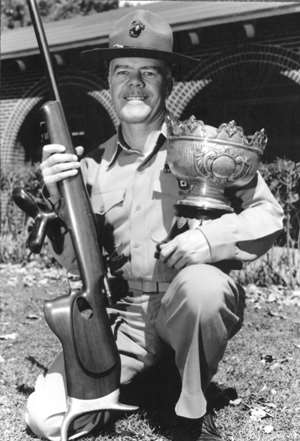
A dentist by profession, Swanson was also a stalwart in the high power discipline. He won the Officers’ Reserve Corps Trophy as a lieutenant in 1936 (that trophy is now a smallbore designation), an award given to the high scoring reserve officer in the high power rifle President’s Match. He was stil a successful high power competitor almost two decades later after serving as the youngest ever NRA president at age 42, from 1948-1949. He continued to shoot smallbore on the International American Team at the 1951 Pan American Games in Buenos Aires, Argentina, and in 1952 pulled out a silver medal in the kneeling stage at the ISU Matches in Oslo, Norway. In 1953, Swanson earned the first ever Hankins Memorial trophy for high power accomplishment, and the Meister Trophy for an aggregate of free rifle and high power matches fired during the National Matches. He captained the Olympic team competing in the 1956 Australian games, and he again claimed the Meister in 1957, topping off a shooting career that spanned three decades.
William A. Tewes
Bill Tewes topped the ranks of this country’s riflemen for 37 years, beginning his career at the National Matches of the late 189s at the Sea Girt Range in New Jersey. There he fired with the New Jersey State Rifle Team. Equally proficient in both high power and smallbore disciplines, Tewes earned many prestigious honors including the Wimbledon up in 1905, and the U.S. .22 Caliber Rifle League Championship in both 1907 and 1909, and the Sea Girt Championship in 1910. He was still going strong more than twenty years later when he won the Swiss Match of 1926.
Renowned for his off-hand skills, Tewes maintained a rigorous training schedule during the year 1906, after someone had commented at a match that his rifle shooting wasn’t all that great. That spurred the man to rise at 6 a.m., every morning for a year, to do road work, fire 100 shots to train his reflexes, and adhere to a regimen of “no stimulants.” He also instituted a strict, self-imposed 8:00 p.m. curfew. His hard work paid off. Tewes set a world record for offhand shooting at the 100-shot Indoor Championships of 1907.
A lifetime member of the NRA for 48 years and an employee of the Remington Arms Company, Tewes was committed to passing on his knowledge to others. He proved a more than able coach for state, national and international teams. He had guided the NJSRT from 1904 to 1913 when he took over the coaching duties of the 1913 U.S. Free Rifle Team. He continued in his coaching capacity next for the U.S. Palma Team of 1925, and then for the 192 U.S. Dewar Team’s captain position for the years 1928, 1929, and 1930, and then returned to coaching duties, this time for the 1932 Olympic rifle team. He wrote several articles on coaching for the American Rifleman in 1948 that received widespread attention.
Middleton Tompkins
Middleton Tompkins is the high power counterpart of smallbore’s Lones Wigger. His first major win occurred in 1958 and it was huge. That win was the NRA National Match Rifle Championship, an honor he has repeated six times over the course of the last four decades. He has won most of the major NRA National Match awards for high power competition at least once, and many several times.
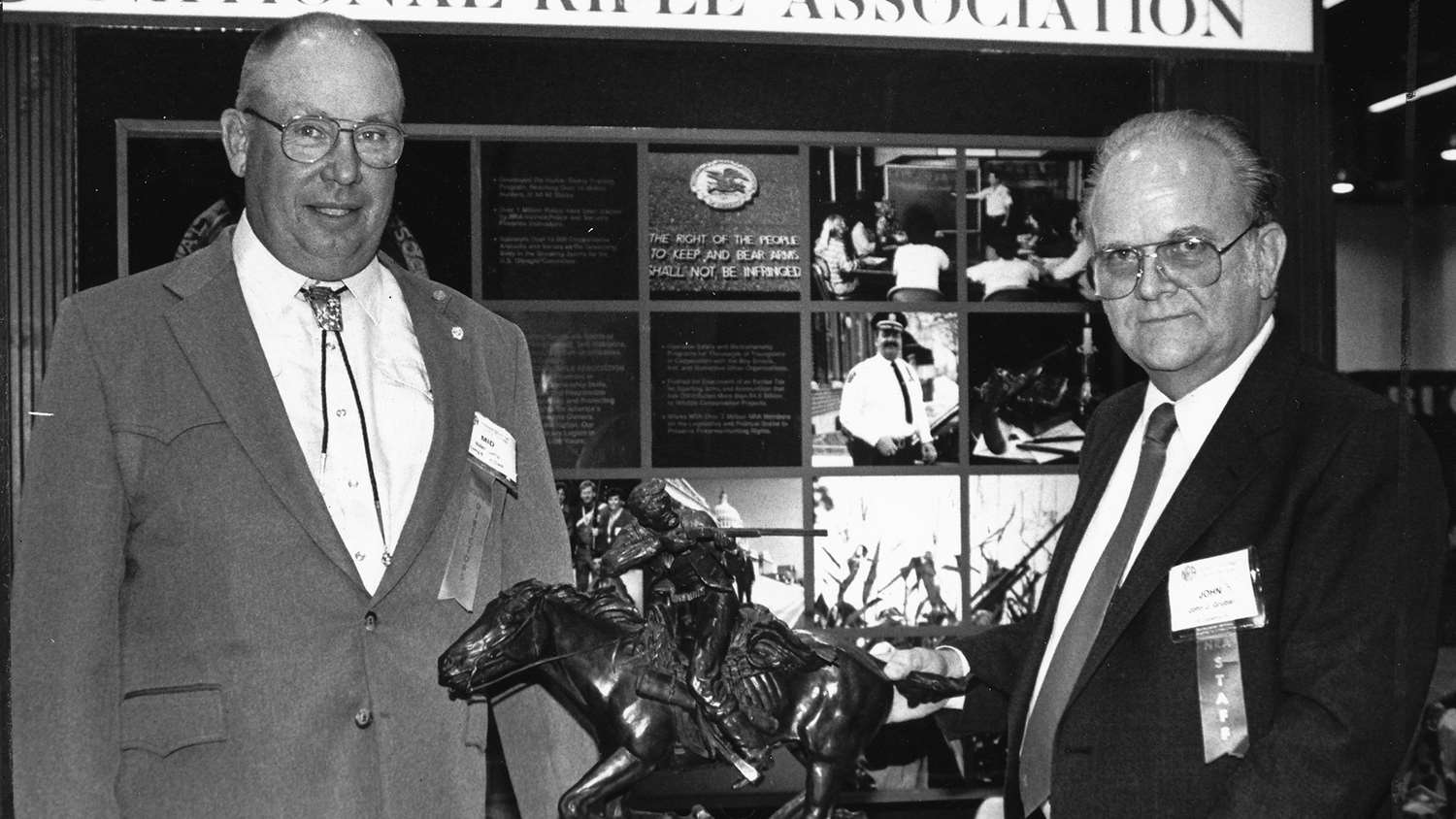
Most astounding in a career that now spans 40-plus years, are both the number of major repeat wins and the length of time over which many of Tompkins’ honors have been accumulated. By example: the Palma Individual in 1970 and then two years later in 1990 and again in 1998; the Nevada Trophy in 1970 and then the passage of more than a quarter century before a return to that award in 1996; the esteemed Leech Cup, won first in 1964 and later in 1987. The list is almost endless.
Still leading the pack, Tompkins captained the 1999 Palma Team, a fitting achievement for a man who has been a member of more Palma teams than any present U.S. shooter. We have all been witness to the passing-on of his vast knowledge of high power skills to his wife Nancy, and stepdaughters Michelle and Sherri, all high power champions of national prestige. His commitment to both his own family and America’s shooting “family” is perhaps one of our best examples today of family values.
Nancy Tompkins-Gallagher
Nancy Tompkins-Gallagher’s place in shooting history was set in 1998 when she became the first woman to win the U.S. National High Power Championship. She has been the National High Power Women’s Champion 13 times. She has been a member of the International Palma Team four times, Tompkins-Gallagher, who lives in Prescott, AZ, currently holds 28 national shooting records and has set a total of 54 records during her career.
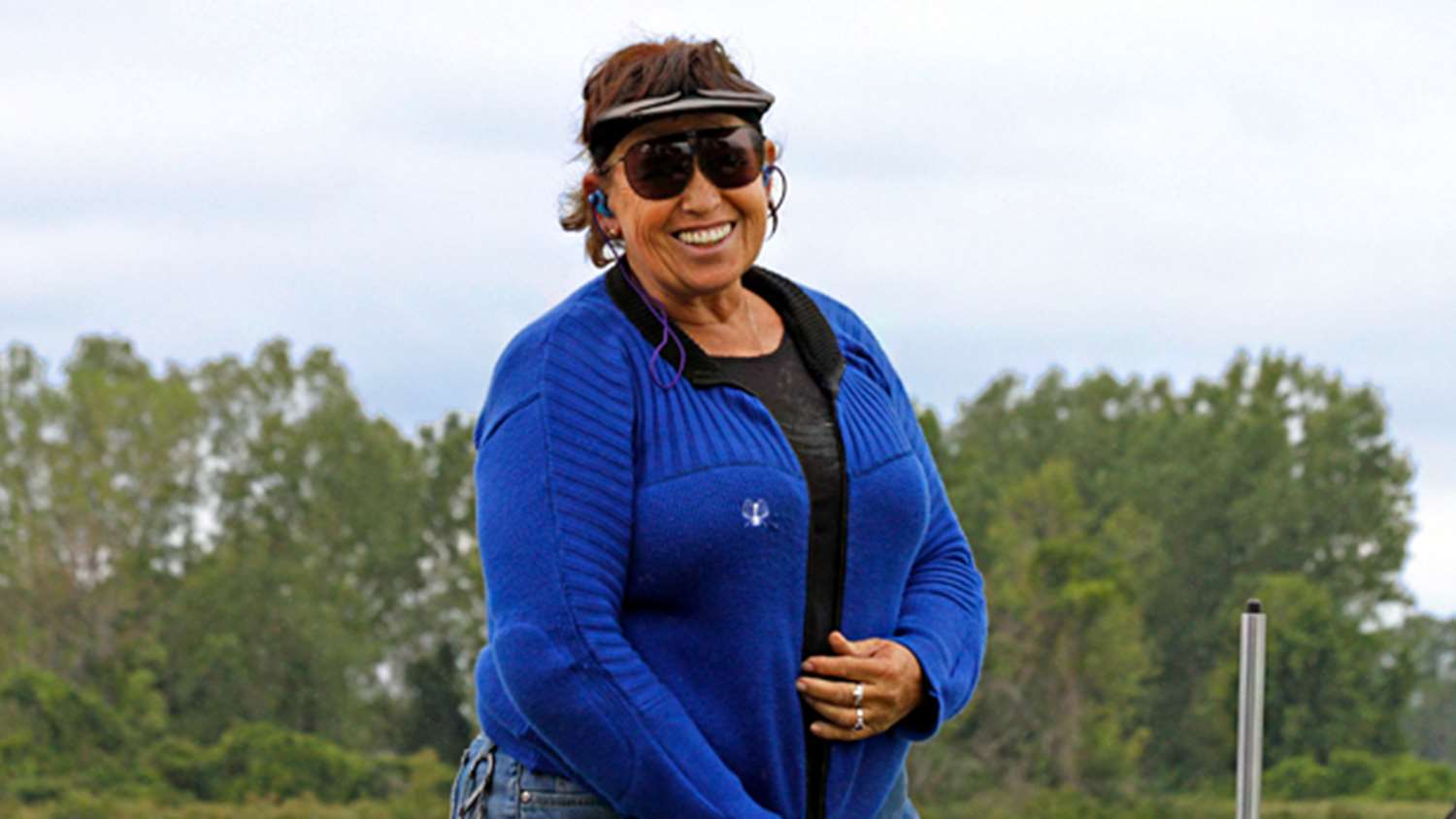
Tompkins-Gallagher grew up in Phoenix, AZ, where she learned to shoot at the age of 10 or 11. She started in hunter education classes, but quickly moved onto smallbore and high power. She began her high power career in 1976 as a junior competitor and won her first national women’s high power title that year. As a smallbore competitor, Tompkins-Gallagher has been a member of both the International Dewar Team and International Randle Team. Her most recent achievements include winning the Tompkins Trophy and both the Canadian and Leech Cups at the 1999 National Matches, and she was the National Long Range Champion in 1997. Her tradition of winning is shared with her husband Middleton, and her two daughters, Michelle and Sherri.
Elizabeth “Plinky” Topperwein
Mrs. Elizabeth “Plinky” Topperwein became the hallmark for competitive shooters of the “softer sex” during the 1906 NRA National Matches at Sea Girt. There the NRA was debuting its National Marksmen’s Reserve program qualifications event for those who wished to compete for is new marksmanship medal. The course of fire was conducted using the standard-issue Krag to fire five shots each at 200-, 300- and 500-yards, kneeling at the closest position. The match was a huge success as competitors lined up throughout the day to try to score at least the minimum of 50 out of a possible 75 points.
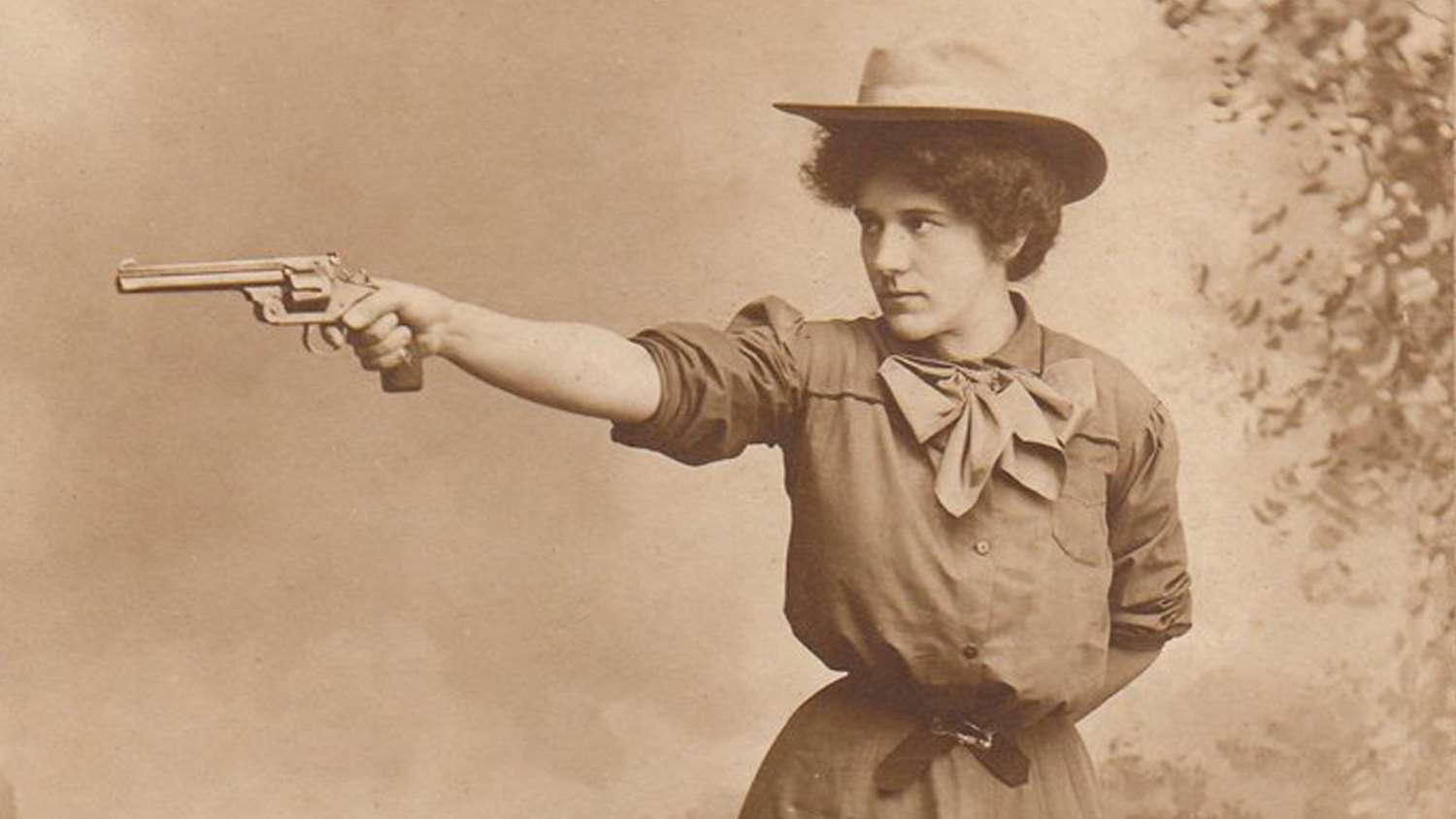
Though many failed the course that day firing the hard-kicking Krag, one of those who did qualify stood out among the rest. Though match officials conversed heatedly about allowing a woman to compete (the match had been advertised as an all-comers match open to civilians), in the end they could find no legitimate reason to prevent Mrs. Elizabeth Topperwein from stepping to the firing line.
Topperwein was no stranger to firearms. She and her husband Adolph were exhibition shooters for the Winchester Repeating Arms Company. She had shattered nearly all records made by Annie Oakley with both rifle and shotguns fired at thrown targets. She could clip tossed coins using a pistol with either hand, and just two months before she braved the ranks of NRA’s National Matches, she had crushed 485 out of 500 clay pigeons in gusting winds to set a new record at the Texas Gun Club’s trap range in San Antonio.
So that day, firing shoulder-to-shoulder with the men, Plinky ran up a score of 61 points, earning her medal to the cheers of legions of male competitors. By broaching the walls of the “boys club,” Elizabeth Topperwein became the first woman in history to compete in an NRA match, opening the path of competition for many more to come.
William B. Woodring
A dominant smallbore force during the decade of the 1930s was William B. Woodring. He gained fame as a firing member of the 1934 Dewar Team that not only beat the British, but set a new record as well. A much respected prone expert, his name appears from that point on with increasing repetition in the record books: as half of a team paired with Clarence C. Held for the Hercules Trophy in 1934; the Critchfield Trophy in back to back wins from 1936 to 1938; the U.S. Cartridge Company Trophy in 1936 and 1938; and the Austin Trophy in 1937, and then again three years later in 1940.
By 1940, Woodring was recognized as one of the world’s leading smallbore shooters, underscored by the fact that in 42 runs over the Dewar Course, Woodring had maintained an average score of 99.63.
Darius “Doc” Young
Darius Young had a long and distinguished career in the U.S. Army Reserve, but his first big win as shown in the trophy records was as a civilian in 1975. That year he earned the Manchester Trophy for the high civilian in the NRA National Pistol Championships. But, it was in 1979 that Young really began to hit his stride, winning both the Harrison and Army Reserve Pistol trophies that began a 20-year ranking as one of the best bullseye shooters in the nation, an honor that continues to this very day.
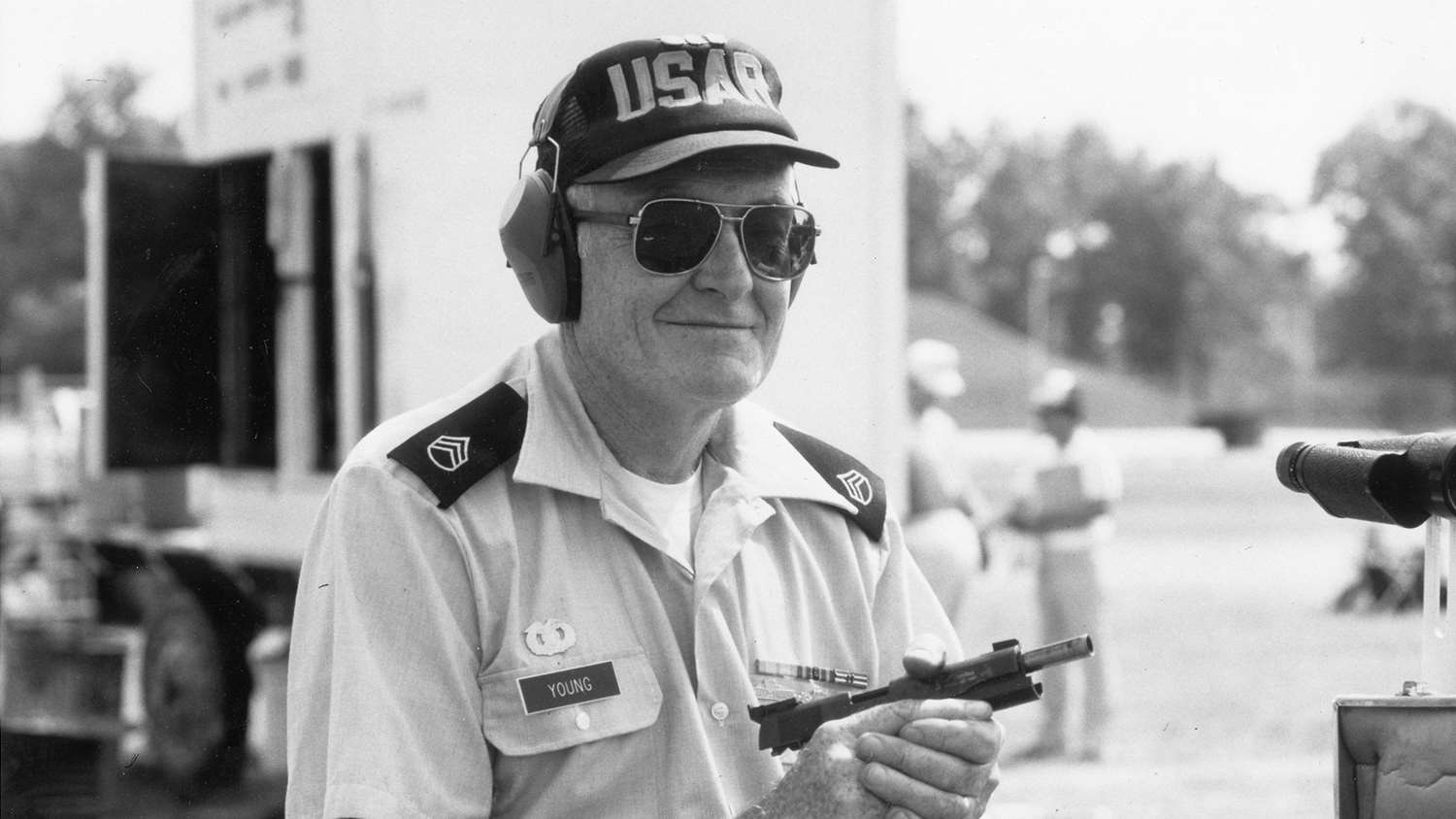
Young’s dominance in the world of bullseye is perhaps best demonstrated by the number of times he’s been elected to the Mayleigh Cup Challenge Team—13. He has also earned prominent wins on the international scene: the Swanwick Trophy for the rapid fire title in the 1980 U.S. International Shooting Championships; the Marvin D. Driver Memorial Trophy in 1981 at the U.S. International Shooting Championships for standard pistol; the U.S. Army Reserve Pistol Trophy for the Center-fire Pistol Championships at the 1981 U.S. Internationals; and the Franklin L. Orth Memorial for the Free Pistol Championship in the same 1981 event.
Even in civilian life Young continues to secure title after title. In 1999 he earned another appearance on the Mayleigh Cup Team, and the Civilian Championship and the Senior Championship titles at the NRA National Matches. He then joined Team Ultra-Dot to become the first civilian team to win the National Team Championship. Young followed up his 1999 week at Camp Perry by taking home the President’s Pistol Trophy.
Noma J. Zinsmaster
An unusual name for an unusual competitor, Noma Zinsmaster has been and continues to be successful in a shooting discipline that’s heavily predominated by men: high power rifle competition. Zinsmaster took her first NRA Women’s High Power National Championship in 1978. She won the same title seven times over the next 10 years. A long range match rifle specialist, Zinsmaster was the first woman to ever win Wimbledon. She was also the first woman to earn the Crowell Trophy, and she has twice won the Army Cup.
This petite lady from Santa Clarita, CA, has taken her state’s high power title four times and has set several national records in her 20-year career. Her crowning achievements have included appearances on the 1988 and 1999 Palma Teams and she won the 1988 Individual World Long Range Woman’s Championship. Today she also coaches junior high power competitors and to some great results: in 1999 she coached the winning Whistler Boy team for high power at Camp Perry.
Part 3 of this series will be coming soon!














